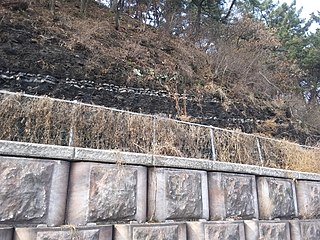
The Paluxy Formation is a geological formation found in Texas, Louisiana, Arkansas, Mississippi and Oklahoma, whose strata date back to the Early Cretaceous. Dinosaur remains are among the fossils that have been recovered from the formation.

The Eagle Sandstone, originally the Eagle Formation, is a geological formation in Montana whose strata date back to the Late Cretaceous. It is a light to brownish gray to pale yellow-orange, fine-grained sandstone. It contains areas of crossbedding and local shale members. It contains large sandy calcareous concretions. Its thickness varies from 100 to 350 feet due to the lens nature of the individual sandstone layers and local interbedded sandy shale layers.
The Merchantville Formation is a geological formation in the northeastern United States whose strata date back to the Late Cretaceous, around the time of the Santonian and Campanian age. Dinosaur remains are among the fossils that have been recovered from the formation.
The Kakanaut Formation is a geological formation in Siberia, whose strata date back to the Late Cretaceous (Maastrichtian). Dinosaur remains are among the fossils that have been recovered from the formation. The flora of the formation is relictual, containing some of the youngest remains of the extinct plant orders Bennettitales and Czekanowskiales.

The Ripley Formation is a geological formation in North America found in the U.S. states of Alabama, Georgia, Mississippi, Missouri, and Tennessee. The lithology is consistent throughout the layer. It consists mainly of glauconitic sandstone. It was formed by sediments deposited during the Maastrichtian stage of the Late Cretaceous. It is a unit of the Selma Group and consists of the Cusseta Sand Member, McNairy Sand Member and an unnamed lower member. It has not been extensively studied by vertebrate paleontologists, due to a lack of accessible exposures. However, fossils have been unearthed including crocodile, hadrosaur, nodosaur, tyrannosaur, ornithomimid, dromaeosaur, and mosasaur remains have been recovered from the Ripley Formation.
The Ashizawa Formation is a Coniacian geologic formation in northeastern Honshu, Japan. Dinosaur remains are among the fossils that have been recovered from the formation, although none have yet been referred to a specific genus. A jawbone belonging to a therian mammal has also been discovered from this unit.
The Baiying Bologai Formation, in other literature named Bayan Bologai Formation, is an Early Cretaceous geologic formation in the Ömnögovi Province of Mongolia. Dinosaur remains are among the fossils that have been recovered from the formation, although none have yet been referred to a specific genus.
The Birdrong Sandstone is an Early Cretaceous geologic formation of the Barrow Group in Western Australia. Dinosaur remains are among the fossils that have been recovered from the formation, although none have yet been referred to a specific genus.
The Packard Formation is a Mesozoic geologic formation. The formation may be from the Kirtlandian land vertebrate age. It has a similar fauna to the Corral de Enmedio Formation.
The Tsagaantsav Formation, Tsagantsab Formation or Tsagan-Tsab Formation is an Early Cretaceous geologic formation in Mongolia. Indeterminate sauropod and psittacosaurid remains have been recovered from the formation. Remains of the pterosaur Noripterus, which were originally given their own genus, "Phobetor" have also been recovered from the formation.
The Gugyedong Formation, also known as the Guyedong Beds, is an Aptian to Albian geologic formation in South Korea. Dinosaur remains diagnostic to the genus level are among the fossils that have been recovered from the formation.
The Harebell Formation is a Late Cretaceous (Maastrichtian) geologic formation in Wyoming which outcrops in parts of the Yellowstone National Park. Dinosaur remains diagnostic to the genus level are among the fossils that have been recovered from the formation.
The Marshalltown Formation is a Mesozoic geologic formation. Dinosaur remains diagnostic to the genus level are among the fossils that have been recovered from the formation.
The Severn Formation is a Mesozoic geologic formation in Maryland. Dinosaur remains diagnostic to the genus level are among the fossils that have been recovered from the formation.
The Kiyosu-e Formation is a Middle Jurassic (Callovian) to Early Cretaceous (Berriasian) geologic formation of the Toyonishi Group in Yamaguchi Prefecture, Japan. Fossil ornithopod tracks have been reported from the formation.

The Hensel Formation or Hensel Sand is a Mesozoic geologic formation in Texas. Fossil ornithopod tracks have been reported from the formation.

The Geoncheonri Formation is an Early Cretaceous (Aptian-Albian) geologic formation of the Hayang Group in the Gyeongsang Basin of southeast South Korea. Fossil ornithopod tracks, as well as fossils of Kirgizemys have been reported from the lacustrine siltstones and mudstones of the formation.
The Akaiwa Formation is an Early Cretaceous (Hauterivian-Barremian) geologic formation in central Honshu, Japan. Indeterminate ornithischian fossils are known from the formation. Fossil ornithopod tracks have been reported from the formation. As well as the turtle Kappachelys
The Ialovachsk or Yalovach Formation is a geologic formation in Kyrgyzstan, Tajikistan and Uzbekistan dating to the Santonian age of the Cretaceous period.
The Cedar District Formation is a geologic formation exposed on Vancouver Island, the Gulf Islands of British Columbia and San Juan Islands of Washington (state). It preserves fossils dating back to the Campanian Epoch of the Cretaceous period. It dates to the lower mid-Campanian.



